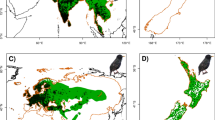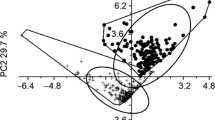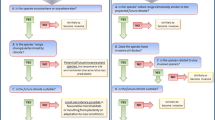Abstract
Knowledge of the ecological niches of invasive species in native and introduced ranges can inform management as well as ecological and evolutionary theory. Here, we identified and compared factors associated with the distribution of an invasive tree, Ailanthus altissima, in both its native Chinese and introduced US ranges and predicted potential US distribution. For both ranges separately, we selected suites of the most parsimonious logistic regression models of occurrence based on environmental variables and evaluated these against independent data. We then incorporated information from both ranges in a simple Bayesian model to predict the potential US distribution. Occurrence of A. altissima in both ranges exhibited a unimodal response to temperature variables. In China, occurrence had negative relationships with topographic wetness and forest cover and positive relationships with precipitation and agricultural and urban land use. In the US, A. altissima was associated with intermediate levels of forest cover and precipitation. The Bayesian model identified 58–80% of 10-arc minute grid cells in the conterminous US as containing suitable areas for A. altissima. The best model developed from Chinese data applied to the US matched most areas of observed occurrence but under-predicted occurrence in lower probability areas. This discrepancy is suggestive of a broadening of the ecological niche of A. altissima and may be due to such factors as less intense competition, increased potency of allelopathy, and novel genotypes formed from multiple introductions. The Bayesian model suggests that A. altissima has the potential to substantially expand its distribution in the US.





Similar content being viewed by others
References
Akaike H (1974) New look at statistical-model identification. IEEE Trans Automat Contr AC 19:716–723
Albright TP, Anderson DP, Keuler NS, Pearson SM, Turner MG (2009) The spatial legacy of introduction: Celastrus orbiculatus in the southern Appalachians. J Appl Ecol (in press)
Anderson RP, Lew D, Peterson AT (2003) Evaluating predictive models of species’ distributions: criteria for selecting optimal models. Ecol Modell 162:211–232
Austin MP (2002) Spatial prediction of species distribution: an interface between ecological theory and statistical modelling. Ecol Modell 157:101–118
Austin M (2007) Species distribution models and ecological theory: a critical assessment and some possible new approaches. Ecol Modell 200:1–19
Blossey B, Notzold R (1995) Evolution of increased competitive ability in invasive nonindigenous plants—a hypothesis. J Ecol 83:887–889
Boyce MS, Vernier PR, Nielsen SE, Schmiegelow FKA (2002) Evaluating resource selection functions. Ecol Modell 157:281–300
Brown JH, Lomolino MV (1998) Biogeography. Sinauer Associates, Sunderland, p 691
Burnham KP, Anderson DR (2002) Model selection and multimodel inference: a practical information-theoretic approach. Springer, New York, p 488
Callaway RM, Aschehoug ET (2000) Invasive plants versus their new and old neighbors: a mechanism for exotic invasion. Science 290:521–523
Chen H, Chen LJ, Albright TP (2007) Predicting the potential distribution of invasive exotic species using GIS and information-theoretic approaches: a case of ragweed (Ambrosia artemisiifolia L.) distribution in China. Chin Sci Bull 52:1223–1230
Clark JS (2005) Why environmental scientists are becoming Bayesians. Ecol Lett 8:2–14
Cohen JE (1960) A coefficient of agreement for nominal scales. Educ Psychol Measur 20:37–46
Easterling DR, Meehl GA, Parmesan C, Changnon SA, Karl TR, Mearns LO (2000) Climate extremes: observations, modeling, and impacts. Science 289:2068–2074
Elith J, Graham CH, Anderson RP, Dudik M, Ferrier S, Guisan A, Hijmans RJ, Huettmann F, Leathwick JR, Lehmann A, Li J, Lohmann LG, Loiselle BA, Manion G, Moritz C, Nakamura M, Nakazawa Y, Overton JM, Peterson AT, Phillips SJ, Richardson K, Scachetti-Pereira R, Schapire RE, Soberon J, Williams S, Wisz MS, Zimmermann NE (2006) Novel methods improve prediction of species’ distributions from occurrence data. Ecography 29:129–151
Fielding AH, Bell JF (1997) A review of methods for the assessment of prediction errors in conservation presence/absence models. Environ Conserv 24:38–49
Gray A (1846) Analogy between the flora of Japan and that of the United States. Am J Sci Arts II 2:135–136
Greer G, Aldrich PR (2005) Genetics and biochemical variation of US Ailanthus altissima populations: a preliminary discussion of a research plan. 16th US Department of Agriculture interagency research forum on gypsy moth and other invasive species. USDA Forest Service, Northeastern Research Station, Annapolis
Guisan A, Thuiller W (2005) Predicting species distribution: offering more than simple habitat models. Ecol Lett 8:993–1009
Guo Q (1999) Ecological comparisons between Eastern Asia and North America: historical and geographical perspectives. J Biogeogr 26:199–206
Heisey RM, Heisey TK (2003) Herbicidal effects under field conditions of Ailanthus altissima bark extract, which contains ailanthone. Plant Soil 256:85–99
Hierro JL, Maron JL, Callaway RM (2005) A biogeographical approach to plant invasions: the importance of studying exotics in their introduced and native range. J Ecol 93:5–15
Hijmans RJ, Cameron SE, Parra JL, Jones PG, Jarvis A (2005) Very high resolution interpolated climate surfaces for global land areas. Int J Climatol 25:1965–1978
Hosmer DW, Lemeshow S (2000) Applied logistic regression. Wiley, New York, p 373
Houghton RA, Hackler JL, Lawrence KT (1999) The US carbon budget: contributions from land-use change. Science 285:574–578
Hutchinson GE (1957) Concluding remarks. Population studies: animal ecology and demography. Cold Spring Harb Symp Quant Biol 22:415–427
Jin MH, Yook J, Lee E, Lin CX, Quan Z, Son KH, Bae KH, Kim HP, Kang SS, Chang HW (2006) Anti-inflammatory activity of Ailanthus altissima in ovalbumin-induced lung inflammation. Biol Pharm Bull 29:884–888
Johnson JB, Omland KS (2004) Model selection in ecology and evolution. Trends Ecol Evol 19:101–108
Johnson CJ, Nielsen SE, Merrill EH, McDonald TL, Boyce MS (2006) Resource selection functions based on use-availability data: theoretical motivation and evaluation methods. J Wildl Manage 70:347–357
Kadmon R, Farber O, Danin A (2004) Effect of roadside bias on the accuracy of predictive maps produced by bioclimatic models. Ecol Appl 14:401–413
Keane RM, Crawley MJ (2002) Exotic plant invasions and the enemy release hypothesis. Trends Ecol Evol 17:164–170
Knapp LB, Canham CD (2000) Invasion of an old-growth forest in New York by Ailanthus altissima: sapling growth and recruitment in canopy gaps. J Torrey Bot Soc 127:307–315
Kowarik I (1995) Clonal growth in Ailanthus altissima on a natural site in West Virginia. J Veg Sci 6:853–856
Lavergne S, Molofsky J (2007) Increased genetic variation and evolutionary potential drive the success of an invasive grass. Proc Natl Acad Sci USA 104:3883–3888
Lee CE (2002) Evolutionary genetics of invasive species. Trends Ecol Evol 17:386–391
Loiselle BA, Jorgensen PM, Consiglio T, Jimenez I, Blake JG, Lohmann LG, Montiel OM (2008) Predicting species distributions from herbarium collections: does climate bias in collection sampling influence model outcomes? J Biogeogr 35:105–116
Loveland TR, Reed BC, Brown JF, Ohlen DO, Zhu Z, Yang L, Merchant JW (2000) Development of a global land cover characteristics database and IGBP DISCover from 1 km AVHRR data. Int J Remote Sens 21:1303–1330
MacArthur RH (1972) Geographical ECOLOGY. Harper & Row Publishers, New York, p 269
Mack RN, Simberloff D, Lonsdale WM, Evans H, Clout M, Bazzaz FA (2000) Biotic invasions: causes, epidemiology, global consequences, and control. Ecol Appl 10:689–710
Manly BF, MacDonald LL, McDonals TL, Thomas DL, Erickson WP (2002) Resource selection by animals: statistical design and analysis for field studies. Kluwer, Dordrecht, p 221
Miller JH (2003) Nonnative invasive plants of southern forests: a field guide for identification and control. General Technical Report, p 93. USDA Forest Service, Southern Research Station, Asheville, NC
Miller JR, Turner MG, Smithwick EAH, Dent CL, Stanley EH (2004) Spatial extrapolation: the science of predicting ecological patterns and processes. Bioscience 54:310–320
Mitchell CE, Agrawal AA, Bever JD, Gilbert GS, Hufbauer RA, Klironomos JN, Maron JL, Morris WF, Parker IM, Power AG, Seabloom EW, Torchin ME, Vazquez DP (2006) Biotic interactions and plant invasions. Ecol Lett 9:726–740
Omernik JM (1987) Ecoregions of the conterminous United States. Ann Assoc Am Geogr 77:118–125
Peduzzi P, Concato J, Kemper E, Holford TR, Feinstein AR (1996) A simulation study of the number of events per variable in logistic regression analysis. J Clin Epidemiol 49:1373–1379
Peterson AT (2001) Predicting species’ geographic distributions based on ecological niche modeling. Condor 103:599–605
Peterson AT (2003) Predicting the geography of species’ invasions via ecological niche modeling. Q Rev Biol 78:419–433
R Development Core Team (2006) R: a language and environment for statistical computing. R Foundation for Statistical Computing, Vienna
Spiegelhalter D, Thomas A, Best N (1999) WinBUGS version 1.2 user manual. MRC Biostatistics Unit, Cambridge
Trifilo P, Raimondo F, Nardini A, Lo Gullo MA, Salleo S (2004) Drought resistance of Ailanthus altissima: root hydraulics and water relations. Tree Physiol 24:107–114
USGS (1996) HYDRO1k elevation derivative database. Retrieved from http://lpdaac.usgs.gov/gtopo30/hydro/index.asp on 22 February 2004
Welk E (2004) Constraints in range predictions of invasive plant species due to non-equilibrium distribution patterns: Purple loosestrife (Lythrum salicaria) in North America. Ecol Modell 179:551–567
Williams JW, Shuman BN, Webb T (2001) Dissimilarity analyses of late-quaternary vegetation and climate in eastern North America. Ecology 82:3346–3362
Yan X, Zhenyu L, Gregg WP, Dianmo L (2001) Invasive species in China—an overview. Biodivers Conserv 10:1317–1341
Zhang PC, Shao GF, Zhao G, Le Master DC, Parker GR, Dunning JB, Li QL (2000) Ecology—China’s forest policy for the 21st century. Science 288:2135–2136
Zhu ZL, Waller E (2003) Global forest cover mapping for the United Nations Food and Agriculture Organization Forest Resources Assessment 2000 program. For Sci 49:369–380
Zweig MH, Campbell G (1993) Receiver-operating characteristic (ROC) plots—a fundamental evaluation tool in clinical medicine. Clin Chem 39:561–577
Acknowledgments
Research funded by United States Geological Survey grant (144-ME50). Specimen data was accessed from the following herbaria and databases: MO, ARIZ, ASU, AUA, calflora, CM, COLO, CRISIS, FTG, ILLS, INVADERS, IPANE, KUN, LL, LSU, MIL, MISS, MO, MOR, MSC, NY, OKL, OS, OSC, PH, PUL, SAT, SJSU, TAES, TAMU, TEX, UNA, USNM, WIS, JEPS, WTU, UCR, MONTU, F, NAU, UMO, SUWS, UWPL, WSP, UA, USGB, CSUC, QUE, UNB, UBC, NSPM, ALTA, SASK, PE, KUN. The assistance from these institutions is greatly appreciated. We especially thank curators and staff at Missouri Botanical Gardens, The Field Museum, and The Institute of Botany of the Chinese Academy of Sciences for exceptional assistance during our visits there. TPA thanks N. Keuler for statistical consultation, M. Turner and V. Radeloff for comments and support in completing this work, and Z. Zhu for facilitating this collaboration. QG was also supported by National Science Foundation grant (DEB-0640058) and USDA. Comments by two anonymous reviewers improved this manuscript. Author contributions: TPA, QFG, and LJC conceived the study; TPA, QFG, LJC, and CH collected the data; TPA, LJC, and CH analyzed the data; and TPA led the writing.
Author information
Authors and Affiliations
Corresponding author
Electronic supplementary material
Below is the link to the electronic supplementary material.
Rights and permissions
About this article
Cite this article
Albright, T.P., Chen, H., Chen, L. et al. The ecological niche and reciprocal prediction of the disjunct distribution of an invasive species: the example of Ailanthus altissima . Biol Invasions 12, 2413–2427 (2010). https://doi.org/10.1007/s10530-009-9652-8
Received:
Accepted:
Published:
Issue Date:
DOI: https://doi.org/10.1007/s10530-009-9652-8




